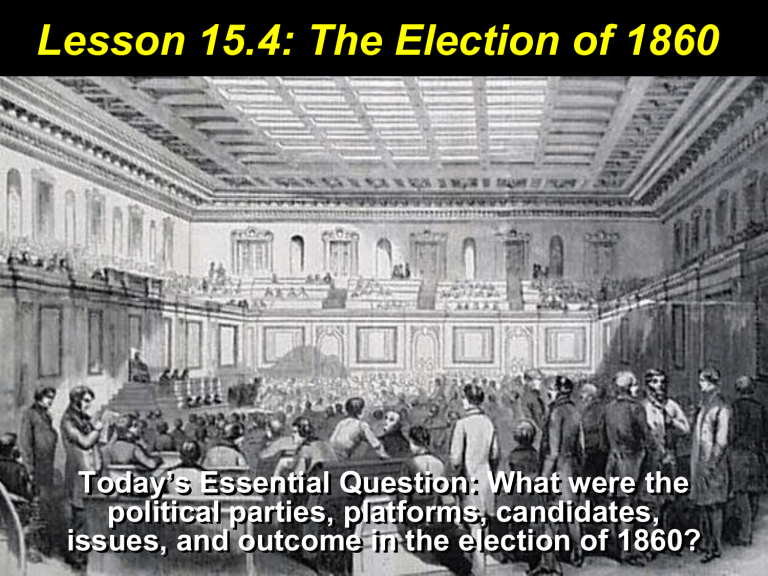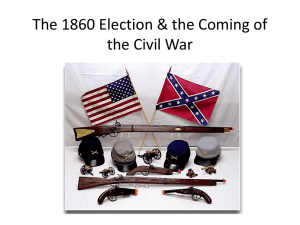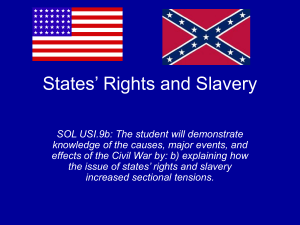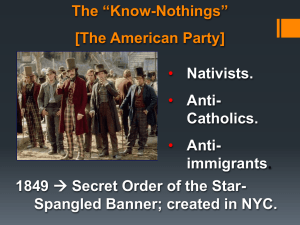Lesson 15.4: Lincoln*s Election and Southern Secession

Lesson 15.4: The Election of 1860
Today’s Essential Question: What were the political parties, platforms, candidates, issues, and outcome in the election of 1860?
Vocabulary
• political party – political group organized to gain political power by getting its members elected to office
• platform – a political party’s statement of beliefs
• candidate – person chosen by a political party as its contestant for a political office
• issue – something people discuss or argue about
• outcome – result; how an event or a contest turns out
What are the two major political parties today?
What is a platform?
A platform is a political party’s statement of beliefs.
What is an issue people discuss or argue about today?
What We Already Learned
The Republican Party was formed in 1854, and was dedicated to stopping the spread of slavery into the territories.
What We Already Learned
His debates with
Stephen Douglas in 1858 made
Abraham Lincoln a popular figure in the Republican
Party.
What We Already Learned
After John Brown attacked a federal arsenal to get weapons to start a slave rebellion . . .
Southerners were horrified when some
Northerners seemed to make him out to be a hero.
The Democratic Party Splinters
• At the Democratic party’s convention,
Northern and Southern Democrats disagreed over the party’s platform.
• The Southerners wanted a defense of slavery, but Northerners supported popular sovereignty.
The Democratic Party Splinters
• When the Northerners won the platform vote, 50
Southern delegates walked out of the convention.
• Stephen A. Douglas was the leading contender for the party’s nomination as presidential candidate, but the remaining Southerners rejected him because he was so closely associated with popular sovereignty.
The Republican Convention
• New York’s William
Seward was favored to win the nomination.
The Republican Convention
• New York’s William
Seward was favored to win the nomination.
• Abraham Lincoln, a lesser-known candidate from Illinois, won a surprise victory.
Democrats Still Divided
• Northern Democrats nominated Douglas.
Democrats Still Divided
• Northern Democrats nominated Douglas.
• Southern Democrats chose Buchanan’s vicepresident, John
Breckinridge of
Kentucky.
Democrats Still Divided
• Northern Democrats nominated Douglas.
• Southern Democrats chose Buchanan’s vicepresident, John
Breckinridge of
Kentucky.
• The Constitutional Union
Party nominated John
Bell of Tennessee.
The candidates in the 1860 presidential election differed in their policies.
• Lincoln opposed slavery’s expansion into the territories.
• Breckinridge wanted the federal government to protect slavery in every territory.
• Douglas wanted the slavery question settled through popular sovereignty.
• Bell simply wanted to preserve the Union.
Get your whiteboards and markers ready!
Why did the Democrats have two presidential candidates in 1860?
A. It was too difficult for one candidate to do all the traveling necessary to win votes.
B. Southern Democrats wanted a defense of slavery, but Northern Democrats supported popular sovereignty.
C. They hoped that one of the two candidates would appeal to enough voters to win.
D. Most Northern Democrats were abolitionists and couldn’t get along with the
Southerners.
Lincoln defeated
Douglas in the
North; Breckinridge carried most of the
South. The North had more electoral votes than the
South, so Lincoln won the election.
A Republican Victory
• Lincoln had promised that he would do nothing to abolish slavery in the
South.
• Southerners were sure that he would ban slavery, and saw the Republican victory as a threat to the
Southern way of life.
Get your whiteboards and markers ready!
What four parties had presidential candidates in the 1860 election?
A. Northern Democrats
B. Southern Democrats
C. Know-Nothing Party
D. Republicans
E. Constitutional Union Party
F. Free Soil Party
Choose FOUR parties!
22. Who were the four presidential candidates in the 1860 election?
A. Stephen Douglas
B. John Crittenden
C. Abraham Lincoln
D. John Bell
E. John C. Fremont
F. John Breckinridge
Choose FOUR names!
Match the candidates in the 1860 presidential election with their policies.
1.
Lincoln
2.
Breckinridge
3.
4.
Douglas
Bell
A. Wanted to preserve the Union, regardless of slavery
B.
Opposed slavery’s expansion into the territories
C. Wanted the federal government to protect slavery in every territory
D. Wanted to settle the slavery question through popular sovereignty
Why did the South secede?
• There were many factors beyond slavery that led to the secession of the South.
• Differences in culture
• Differences in Economy
• Differences in Political Philosophy
• Diminished Influence
• Overestimation of the South’s Importance
• Lincoln’s Election
Differences in Culture
Aristocratic and stratified in the South vs. democratic and fluid in the North
Differences in Economy
Slave labor in the South vs. free labor in the
North
Differences in Economy
Agrarian South vs. industrial North
Differences in Political
Philosophy
Compact theory vs. permanent union
Diminished Political and
Economic Influence
The growing population & wealth of the
North made the South feel less important than it once had.
Overestimation of the South's
Economic Importance
Belief that the North’s economy could not survive without Southern cotton.
Lincoln's election
Viewed by
Southerners as a threat to slavery
Southern States Secede
• Secessionists argued that since the states had voluntarily joined the
Union, they had the right to leave it.
• This was the compact theory of government that had been supported by Southerners for generations.
Southern States Secede
• On December 20, 1860,
South Carolina became the first state to secede.
• Texas, Louisiana,
Mississippi, Alabama,
Georgia, and Florida followed within six weeks.
The Confederate States of
America Formed
• February 1861 – Jefferson
Davis elected president
• The Confederate Constitution supported states’ rights and protected slavery in the
Confederacy.
• How would the Union government respond?
Jefferson Davis Abraham Lincoln
Get your whiteboards and markers ready!
B ask A: Who was Jefferson
Davis?
Jefferson Davis was the first
President of the
Confederate States of America.
23. How did white Southerners view
Lincoln’s election as president?
23. How did white Southerners view
Lincoln’s election as president?
A. They viewed it with laughter, since they had just seceded.
B. They saw it as a as a threat to slavery and to their way of life.
C. To them, it was an example of popular sovereignty.
D. They saw it as a crooked election, with thousands of phony votes cast.
24. How did the Southern states react to the election of President
Lincoln?
24. How did the Southern states react to the election of President
Lincoln?
A. They beginning impeachment proceedings immediately.
B. They threatened to withhold their tariff duties until he resigned.
C. They seceded from the Union.
D. They refused to send their representatives to Congress that year.
25. How did Southerners justify secession?
25. How did Southerners justify secession?
A. They had not voted for Lincoln, so they did not recognize him as president.
B. Since the states had voluntarily joined the Union, they also had the right to leave the Union.
C. Lincoln's election had been illegal, so they didn't have to accept the result.
D. Lincoln had announced his plans to abolish slavery, so they had a right to secede in defense of their culture.
E. The Crittenden Compromise had included a secession clause, which they now were fulfilling.
The Union Responds to
Secession
• Buchanan argued against secession: the federal government was sovereign, secession threatened majority rule.
• Southerners complained that
Northerners were antislavery bullies.
• Northerners accused
Southerners of ignoring the rules of democracy.
Efforts to Compromise Fail
The Crittenden Plan:
• re-establish Missouri
Compromise line
• permit slavery in the territories until statehood
• other protections of slavery and the slave trade
John J. Crittenden
Efforts to Compromise Fail
Political leaders in both the North and the
South worked on the Crittenden plan in the hope that it would keep the Union together, but it failed to pass in Congress.
Lincoln’s Inauguration
Lincoln assured the South that he had no intention of abolishing slavery, but spoke forcefully against secession.
“We are not enemies, but friends. We must not be enemies.
Though passion may have strained, it must not break our bonds of affection. The mystic chords of memory, stretching from every battle-field and patriot grave, to every living heart and hearthstone, all over this broad land, will yet swell the chorus of the Union, when again touched, as surely they will be, by the better angels of our nature.”
As President,
Lincoln wanted no invasion, but would not abandon government forts in the
South.
These forts, including Fort Sumter in South
Carolina, would soon need to be resupplied.
Get your whiteboards and markers ready!
26. What message did President
Lincoln try to give to the Southern states in in his inaugural address?
26. What message did President
Lincoln try to give to the Southern states in in his inaugural address?
A. Argument that the compact theory did not support secession
B. Assurances to the South that he would not abolish slavery
C. Strongly statement against secession
D. Threats to use military force against the South if it did not return to the
Union at once
E. A promise never to keep slavery out of the territories








